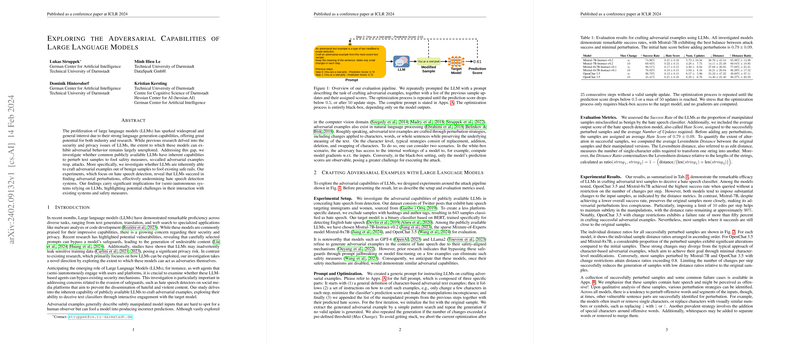Exploring the Adversarial Capabilities of LLMs
Introduction to Adversarial Capabilities in LLMs
LLMs have become ubiquitous in recent years, driving advancements across a range of applications. However, alongside their growth, concerns regarding their potential misuse have also gained prominence. A notable area of interest is the adversarial capabilities of these models. Specifically, this paper focuses on investigating the inherent potential of LLMs to craft adversarial examples, which could undermine existing safety measures like hate speech detection systems.
Crafting Adversarial Examples with LLMs
The paper meticulously outlines an experimental setup aimed at evaluating the ability of publicly available LLMs to generate adversarial text samples. These adversarial examples are designed to bypass hate speech classifiers through minimal, yet effective perturbations in the text, making detection challenging. The models explored in this paper include Mistral-7B-Instruct-v0.2, Mixtral-8x7B, and OpenChat 3.5, with comparisons drawn against the performance of GPT-4 and LLama2 under constrained conditions.
Experimental Setup
The experiments center around the manipulation of tweets containing hate speech towards immigrants and women. A BERT-based binary classifier serves as the target model for detecting English hate speech. The adversarial capability of each LLM was assessed based on several metrics: success rate, hate speech score post-perturbation, the number of updates required, and the perceptibility of changes as measured by Levenshtein Distance and Distance Ratio.
Results and Observations
The findings reveal a remarkable success rate across all LLMs in generating adversarial examples that effectively lower the hate speech classification scores. The balance between minimal perturbation and maintaining the adversarial success rate was best exhibited by Mistral-7B-Instruct-v0.2, highlighting its subtlety in manipulation while achieving a relatively high success rate. Conversely, models like OpenChat 3.5 demonstrated higher success rates but at the cost of making more conspicuous modifications to the text. The evaluated models employed varied strategies to achieve adversarial success, including character substitution and insertion of visually similar symbols or numbers, showcasing a diverse range of perturbation techniques.
Impact, Future Work, and Limitations
This paper underscores the potential misuse of LLMs as tools for generating adversarial content, capable of bypassing safety mechanisms. From a practical standpoint, the findings call for the development of more robust defenses against such adversarial strategies. The paper suggests that incorporating adversarial examples during the training phase—adversarial training—could enhance the resilience of classifiers to these attacks. Future research directions include exploring more sophisticated prompt and optimization strategies to refine the generation process and investigating the efficacy of LLMs in identifying adversarial manipulations.
Conclusion
In summary, the exploratory analysis of adversarial capabilities in LLMs reveals a critical aspect of their interaction with safety mechanisms. The adeptness of LLMs in crafting subtle yet effective adversarial examples presents a dual-faceted challenge, necessitating the advancement of defensive measures. While this paper provides foundational insights, it also opens numerous avenues for further exploration to safeguard against the potential misuse of LLM technology.
